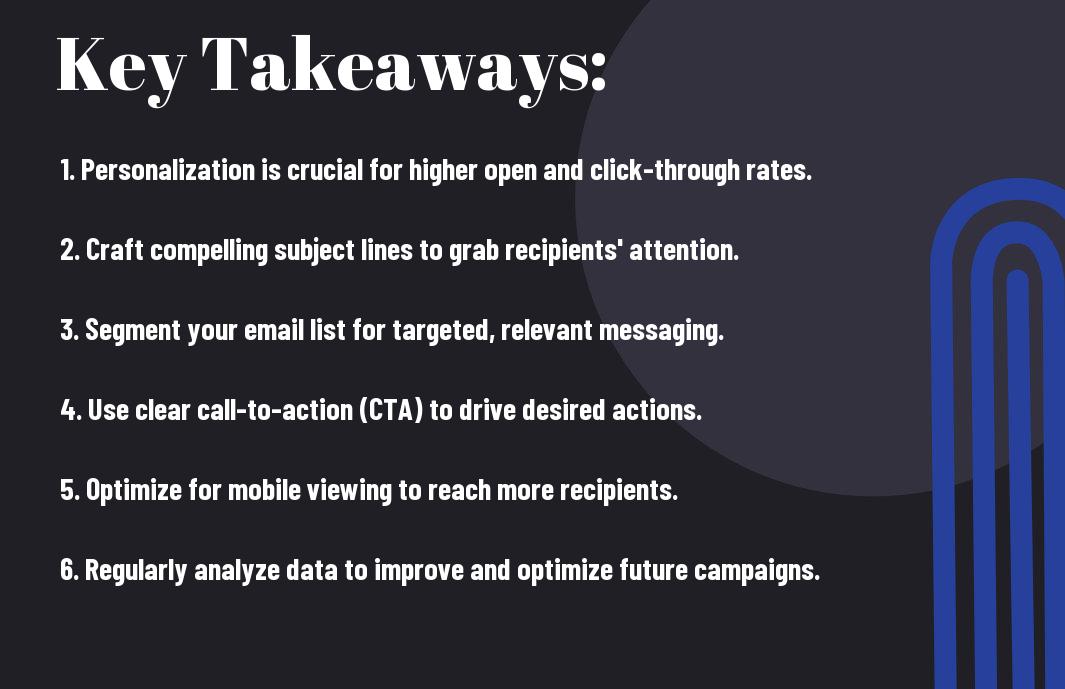Are you looking for an effective way to reach out to potential customers and drive sales for your US-based business? Look no further than email marketing campaigns. In today’s digital age, email marketing remains one of the most powerful tools for businesses to promote their products and services, engage with their target audience, and ultimately boost their bottom line.
When done right, email marketing campaigns can deliver an impressive return on investment, allowing you to reach a large number of potential customers at a fraction of the cost of traditional advertising methods. However, without a strategic approach, email marketing can also be a double-edged sword, potentially damaging your brand’s reputation and driving customers away.
In this blog post, we will explore the ins and outs of email marketing campaigns for US businesses, providing you with the knowledge and tools you need to create successful, high-converting email campaigns. From building a targeted email list to crafting compelling content and optimizing your email design for maximum impact, we will cover everything you need to know to harness the power of email marketing for your business. So, sit back, grab a notebook, and get ready to take your email marketing game to the next level!
Table of Contents
ToggleKey Takeaways:
- Email marketing is an effective strategy for US businesses to reach and engage with their target audience.
- Segmentation is crucial for successful email campaigns, allowing businesses to tailor their content to specific customer groups.
- Personalization in email marketing can significantly improve open rates and overall engagement with customers.
- Mobile optimization is essential, as a large portion of US consumers access their emails on their smartphones.
- CTAs must be clear and compelling to drive the desired action from recipients.
- Testing and analytics are important for refining email campaigns and understanding what resonates with the audience.
- Compliance with CAN-SPAM Act is critical for US businesses to avoid legal issues and maintain credibility with their audience.

The Anatomy of Effective Email Marketing
Assuming you’re looking to launch a successful email marketing campaign, it’s crucial to understand the key components that make up an effective strategy. From the content and design of your emails to the timing of your sends, each element plays a critical role in engaging your audience and driving results for your business. In this chapter, we’ll explore the core components of an email marketing campaign and provide insights into designing emails for maximum engagement.
Core Components of an Email Marketing Campaign
When it comes to crafting a successful email marketing campaign, several core components must be carefully considered. Firstly, the quality of your email list is paramount. Segmenting your list based on specific criteria such as demographics, past purchase behavior, or engagement with previous emails allows you to target your messaging effectively. Additionally, compelling subject lines and personalized content are crucial to capturing the attention of your recipients and driving open rates. The design and layout of your emails, as well as the call-to-action (CTA) placement, are also key components that can significantly impact the success of your campaign. Finally, measuring and analyzing the performance of your emails through metrics such as open rates, click-through rates, and conversion rates is essential for optimizing future campaigns.
Designing an Email for Maximum Engagement
When it comes to designing an email for maximum engagement, there are several best practices to keep in mind. First and foremost, your emails should be visually appealing and optimized for mobile devices. Using eye-catching visuals and concise, scannable content can capture the attention of your recipients and encourage them to take action. Ensuring that your emails are relevant and valuable to your audience is also crucial for driving engagement. This can be achieved through personalized recommendations, exclusive offers, or informational content that addresses your audience’s pain points. A clear and compelling call-to-action should also be prominently featured in your emails to prompt recipients to take the desired action, whether it’s making a purchase, signing up for an event, or downloading a resource. Testing different elements of your email design and content can help you identify what resonates best with your audience and continuously improve your email marketing efforts.

Building a Robust Email List
Keep in mind that a robust email list is the foundation of successful email marketing campaigns. The quality and size of your email list greatly impact the success of your email campaigns. It’s important to focus on building a strong, engaged subscriber base to ensure your email marketing efforts yield positive results.
Strategies for Growing Your Subscriber Base
If you want to grow your email list, you need to employ various strategies to attract new subscribers. One effective method is to create compelling opt-in incentives, such as exclusive content, discounts, or free resources that provide value to your audience. You can also utilize social media and website sign-up forms to capture new leads. Additionally, consider running targeted advertising campaigns to reach a wider audience and encourage them to subscribe to your emails. By implementing these strategies, you can expand your subscriber base and increase the effectiveness of your email marketing efforts.
Maintaining List Hygiene for Better Results
It’s essential to regularly clean and maintain your email list to ensure better results from your campaigns. Removing inactive subscribers and correcting invalid email addresses will improve your overall email deliverability and engagement rates. By regularly scrubbing your list, you can avoid sending emails to invalid or non-responsive addresses, which can negatively impact your sender reputation and deliverability. Furthermore, maintaining list hygiene ensures that you are targeting an engaged audience, ultimately leading to better results from your email marketing campaigns.

Navigating Legal Compliance
Not only do your email marketing campaigns need to be compelling, but they also need to comply with various laws and regulations. As a US business, it’s crucial that you understand and abide by these legal requirements to avoid potential penalties and maintain a positive reputation.
Understanding the CAN-SPAM Act
When it comes to email marketing in the US, the CAN-SPAM Act is a key piece of legislation that you need to be familiar with. This law sets the rules for commercial email, establishes requirements for commercial messages, gives recipients the right to have you stop emailing them, and spells out tough penalties for violations. As a business, you must ensure that your emails are compliant with CAN-SPAM by including a valid physical postal address, providing a clear and easy way for recipients to unsubscribe, and not using deceptive subject lines or headers. Failure to comply with this law can result in hefty fines, so it’s essential to have a solid understanding of its requirements.
GDPR and Email Marketing: What US Businesses Need to Know
The General Data Protection Regulation (GDPR) is a European Union law that has implications for US businesses engaged in email marketing. Even if you only market to US-based customers, you still need to be mindful of GDPR if you collect, store, or process personal data of individuals located in the EU. This means that you must obtain clear consent from individuals before sending them marketing emails, provide them with the option to review, update, or delete their data, and ensure that their personal information is securely handled. Non-compliance with GDPR can lead to substantial fines and reputational damage. While the law specifically targets EU data subjects, its impact can be far-reaching, so it’s in your best interest to understand how GDPR may affect your email marketing practices.
Email Marketing Technologies
After you have decided to launch an email marketing campaign for your US business, it’s important to understand the various technologies available to you. Email marketing technologies encompass a variety of platforms and tools designed to help you create, distribute, and manage your email campaigns effectively.
Choosing the Right Email Marketing Platform
When it comes to choosing the right email marketing platform for your US business, you have a variety of options to consider. The platform you choose should align with your specific business needs and goals. Look for a platform that offers easy-to-use email builders, robust automation features, A/B testing capabilities, and detailed analytics to track the performance of your campaigns. Additionally, consider the platform’s scalability to accommodate the growth of your email list and business. Keep in mind that some platforms offer more advanced features geared towards larger enterprises, while others are better suited for small to medium-sized businesses.
Before making a decision, take advantage of free trials offered by many email marketing platforms to test their features and determine which one best fits your needs. Consider the platform’s pricing structure and whether it aligns with your budget and the value it will bring to your business. Furthermore, look for a platform that offers strong deliverability rates to ensure your emails land in your subscribers’ inboxes and not their spam folders.
Automation and Efficient Campaign Management
Utilizing automation in your email marketing campaigns can significantly streamline your efforts and improve efficiency. By automating processes such as welcome emails, follow-ups, and personalized content based on customer behavior, you can save time and deliver more relevant content to your subscribers. Look for a platform that offers robust automation features and integrates seamlessly with your customer relationship management (CRM) system to provide a seamless experience for your subscribers.
Efficient campaign management is essential to the success of your email marketing efforts. Look for a platform that provides a user-friendly interface for creating and scheduling campaigns, as well as detailed reporting and analytics to track your campaign performance. Effective campaign management allows you to optimize your email marketing strategy based on real-time data and insights. Consider the support and resources provided by the platform, including customer service, training, and educational resources to help you maximize the platform’s capabilities.
Measuring Success and Optimization
Despite the effort you put into crafting your email marketing campaigns, the real measure of success lies in the results that you achieve. This is why it’s crucial to have a robust system in place to measure the effectiveness of your campaigns and make necessary optimizations to improve their performance. By analyzing key performance indicators and conducting A/B testing, you can gain valuable insights into what works best for your audience and continuously improve your email marketing strategies.
Key Performance Indicators for Email Marketing
When it comes to measuring the success of your email marketing campaigns, it’s essential to pay attention to key performance indicators (KPIs). These are the metrics that give you insights into how your campaigns are performing and how they are impacting your business. Some of the most important KPIs to track include open rates, click-through rates, conversion rates, and overall engagement. By monitoring these metrics, you can gauge the effectiveness of your campaigns and make data-driven decisions to optimize them for better results.
Open rates are a critical indicator of how well your subject lines and email content are resonating with your audience. A low open rate may indicate that your subject lines are not compelling enough to grab the reader’s attention. A high open rate, on the other hand, suggests that your subject lines are engaging and enticing enough to prompt recipients to open your emails.
Click-through rates indicate the effectiveness of your call-to-action (CTA) and the relevance of your content to your audience. A low click-through rate may suggest that your CTAs are not compelling enough, while a high click-through rate signals that your content resonates with your audience and compels them to take action.
Conversion rates are perhaps the most important KPI to track, as they directly reflect the impact of your email marketing campaigns on your business’s bottom line. By measuring how many recipients took the desired action after clicking through your email, such as making a purchase or signing up for a webinar, you can assess the overall effectiveness of your campaigns in driving real, tangible results.
A/B Testing and Continuous Improvement
A/B testing, also known as split testing, is a powerful strategy for optimizing your email marketing campaigns. By creating two (or more) versions of an email and sending them to different segments of your audience, you can compare their performance and identify which elements resonate best with your recipients. This could include testing different subject lines, CTAs, content formats, or send times. By analyzing the results of these tests, you can refine your campaigns to maximize their impact and continuously improve their performance.
Continuous improvement is key to staying ahead in the ever-evolving landscape of email marketing. By leveraging the insights gained from measuring KPIs and conducting A/B testing, you can make informed decisions to optimize your campaigns for better results. Whether it’s refining your content strategy, enhancing your email design, or fine-tuning your targeting and segmentation, the goal is to consistently improve the effectiveness of your email marketing efforts and drive stronger engagement and conversions.
Case Studies and Industry Insights
To truly understand the effectiveness and impact of email marketing campaigns for US businesses, it’s important to take a closer look at some real-life case studies and gain industry insights. Below are a detailed list of case studies with numbers and data:
- Case Study 1: How a small business in the fashion industry increased its email open rate by 30% in three months
- Case Study 2: The impact of segmentation and personalization on an e-commerce company’s revenue growth
- Case Study 3: Driving customer engagement through targeted email content in the beauty and wellness sector
Analyzing Successful Email Campaigns
When analyzing successful email campaigns, it’s crucial to look at key metrics such as open rates, click-through rates, and conversion rates. You need to pay attention to the subject line, the content, the call-to-action, and the overall design of the email. A/B testing different elements of the email can help you understand what resonates most with your audience. Keeping the content relevant and personalized to the recipient’s interests and behavior is a key factor in the success of an email campaign. Don’t forget to measure and track the success of your campaigns to continually refine your approach.
Lessons from Failed Marketing Efforts
Failure can often be a great teacher. When looking at failed marketing efforts, it’s important to analyze what went wrong and why. Was the email content irrelevant or poorly targeted? Did the subject line fail to grab attention? Were there technical issues with the email delivery? Understanding the reasons behind a failed email campaign can provide invaluable insights that can help you avoid making the same mistakes in the future. Remember, identifying and addressing weaknesses will ultimately lead to stronger, more successful email marketing campaigns for your business.
Advanced Email Marketing Strategies
Now that you have mastered the basics of email marketing, it’s time to explore some advanced strategies that can take your campaigns to the next level. Here are some advanced tactics you can use to optimize your email marketing efforts:
- A/B Testing: This involves sending two different versions of an email to see which one performs better. You can test different subject lines, content, or calls to action to see what resonates best with your audience.
- Segmentation: By segmenting your email list based on criteria such as demographics, behaviors, or purchase history, you can send targeted and personalized emails that are more relevant to your subscribers.
- Automation: Utilizing automation tools to trigger emails based on specific actions or events can help you deliver the right message at the right time, leading to higher engagement and conversions.
Integrating Social Media and Email Outreach
When it comes to maximizing the impact of your marketing efforts, integrating social media and email outreach can be a powerful strategy. By combining the two channels, you can reach your audience through multiple touchpoints, increasing brand exposure and engagement. For example, you can encourage your email subscribers to follow you on social media platforms, or vice versa, to create a more cohesive and interactive experience for your audience. Additionally, integrating social sharing buttons in your emails can facilitate easy sharing of your content, extending your reach and potentially attracting new subscribers.
The Future of Email Marketing: Trends and Predictions
As technology and consumer behavior continue to evolve, email marketing is also undergoing changes. Understanding the latest trends and predictions can help you stay ahead of the curve and adapt your strategies accordingly. One significant trend is the increasing emphasis on personalization, as consumers expect tailored content and experiences. Leveraging artificial intelligence and machine learning technologies to deliver hyper-personalized emails will be key to staying competitive in the future. Moreover, privacy regulations and data protection measures will continue to shape the landscape of email marketing, necessitating a focus on ethical and transparent practices in handling customer data. Embracing interactive and dynamic email content, such as interactive polls, countdown timers, and live social media feeds, can also enhance engagement and drive better results from your campaigns.
Creating a Comprehensive Email Marketing Plan
For US businesses, creating a comprehensive email marketing plan is essential to achieving success in reaching and engaging with your target audience. A well-thought-out plan will help you effectively communicate your message, showcase your brand, and drive conversion. Here’s how to get started on creating a plan that will set your email marketing campaigns up for success.
Establishing Objectives and Setting Goals
Before diving into creating an email marketing campaign, it’s crucial to establish clear objectives and set achievable goals. What do you want to accomplish with your email marketing efforts? Are you looking to increase brand awareness, drive website traffic, generate leads, or boost sales? By defining your objectives, you’ll be able to create targeted and effective campaigns that align with your overall business goals. Setting specific, measurable, achievable, relevant, and time-bound (SMART) goals will provide you with a clear roadmap and benchmarks for evaluating the success of your email marketing campaigns.
When setting your objectives and goals, it’s important to consider the specific metrics you’ll use to measure success. Whether it’s click-through rates, open rates, conversion rates, or other key performance indicators, having a clear understanding of what you want to achieve and how you’ll measure it is crucial for optimizing and improving your campaigns over time. Additionally, consider the audience you are trying to reach and tailor your objectives and goals to their needs and behaviors. Understanding your audience will help you shape your email marketing plan and create content that resonates with them.
Campaign Planning and Execution Steps
Once you’ve established your objectives and goals, it’s time to dive into the campaign planning and execution steps. This includes defining your target audience, crafting compelling content, designing eye-catching visuals, and setting up automated workflows for your campaigns. Understanding your audience is key to delivering relevant content that drives engagement and conversion. Segment your email list based on demographics, behaviors, or purchase history to ensure that your messages are personalized and impactful. Crafting compelling content involves creating attention-grabbing subject lines, valuable and relevant copy, and clear calls to action. Visual elements such as images, videos, and infographics can enhance the appeal of your emails and capture the attention of your audience.
When it comes to campaign execution, consider the timing and frequency of your emails. A well-thought-out sending schedule can improve open rates and engagement. Implementing automated workflows such as welcome series, abandoned cart emails, or re-engagement campaigns can streamline your email marketing efforts and nurture leads throughout the customer journey. By following these planning and execution steps, you can deliver a seamless and impactful email marketing experience that drives results for your US business.

Summing Up
As you now understand, email marketing campaigns are a crucial tool for US businesses to reach and engage with their target audience. The ability to personalize content, target specific demographics, and track results make email marketing an invaluable strategy for driving sales and building brand loyalty. By implementing strategic email marketing campaigns, you have the potential to significantly increase your business’s ROI and acquire new leads.
Remember, the key to a successful email marketing campaign is to provide relevant and valuable content to your subscribers. This means understanding your audience, segmenting your email lists, and analyzing the results of your campaigns to continuously improve your strategy. Additionally, be sure to stay compliant with email marketing laws, such as the CAN-SPAM Act, to protect your reputation and ensure ethical marketing practices. By following these best practices and staying up-to-date with the latest trends in email marketing, you can maximize the impact of your campaigns and drive success for your business.
FAQ
A: Email Marketing Campaigns for US Businesses is a targeted promotion strategy using email to reach potential and existing customers in the United States.
A: Email Marketing Campaigns are a cost-effective way for US Businesses to reach their target audience, build brand awareness, and drive sales.
A: The key components of a successful Email Marketing Campaign include a compelling subject line, personalized content, clear call to action, and mobile optimization.
A: US Businesses can build an effective email list by offering valuable content, providing opt-in opportunities on their website, and leveraging social media to attract subscribers.
A: Best practices for creating engaging email content include segmenting your audience, personalizing your messages, and incorporating visual elements such as images and videos.
A: US Businesses can measure the success of their Email Marketing Campaigns by tracking metrics such as open rates, click-through rates, conversion rates, and overall ROI.
A: Some common pitfalls to avoid in Email Marketing Campaigns include sending too many emails, not optimizing for mobile, and neglecting to test and analyze campaign performance.
